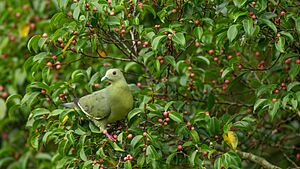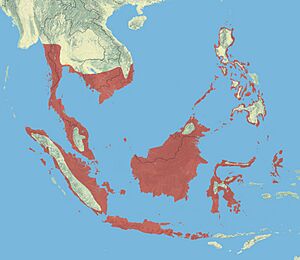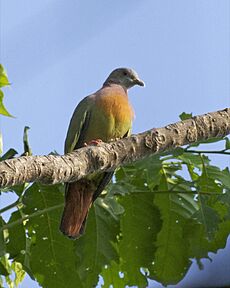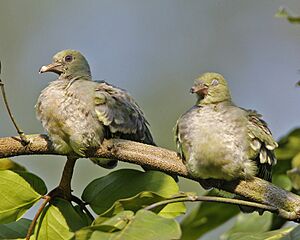Pink-necked green pigeon facts for kids
Quick facts for kids Pink-necked green pigeon |
|
|---|---|
 |
|
| Male in Kent Ridge Park, Singapore | |
 |
|
| Female in Kent Ridge Park, Singapore | |
| Conservation status | |
| Scientific classification | |
| Genus: |
Treron
|
| Species: |
vernans
|
 |
|
| approximate distribution | |
| Synonyms | |
|
|
The pink-necked green pigeon (Treron vernans) is a colorful bird from the pigeon and dove family, Columbidae. It is very common in Southeast Asia, living in countries like Myanmar, Vietnam, Indonesia, and the Philippines.
This pigeon is a medium-sized bird, mostly green. Only the male has the bright pink neck that gives the bird its name. Pink-necked green pigeons live in many different places, from forests to areas changed by humans, like cities. They especially like open spaces. They mainly eat fruit, especially figs.
These birds build simple nests from twigs in trees or bushes. They lay two eggs and both parents help to hatch the eggs and raise the young birds. Pink-necked green pigeons are important because they help spread the seeds of the fruits they eat. They have adapted well to living near people and can be found even in busy cities if there are trees with fruit.
Contents
About Their Name
The famous scientist Carl Linnaeus first described the pink-necked green pigeon in 1771. He called it Columba vernans. The name vernans comes from a Latin word meaning "brilliant" or "flourishing." Later, scientists moved this bird into a group called Treron, which includes other green pigeons.
The official common name for this bird is "pink-necked green pigeon." Sometimes, people just call it the pink-necked pigeon.
What They Look Like
The pink-necked green pigeon is a medium-sized bird, about 25 to 30 centimeters (10 to 12 inches) long. It weighs around 105 to 160 grams (3.7 to 5.6 ounces).
Male and female pigeons look different. This is called sexually dimorphic plumage.
- Males have a gray head, a pink neck, and a pinkish-orange upper chest. Their back is olive green, and their wings are green with black flight feathers and yellow edges. Their belly is yellowish, and their tail is gray with a black band.
- Females are a bit smaller. They have a yellowish belly, throat, and face, with a greenish head and back of the neck. Otherwise, they look similar to the males.
Both males and females have pink or reddish legs and a bill that can be white, pale blue-green, or gray. Young birds look like females but are grayer.
Unlike many pigeons that coo, these green pigeons often make whistling and quacking sounds. Males make a special three-part whistling call that ends with a coo. They also make a rough krrak krrak... sound. They are not very noisy birds, usually only calling when they are in groups or find food.
Where They Live and Their Home
Pink-necked green pigeons live in a wide area, from southern Myanmar, Thailand, Cambodia, and Vietnam, south through the Malay Peninsula and many islands like Indonesia and the Philippines.
They live in many different places, including:
- Old forests
- Edges of forests
- Newer forests that have grown back
- Coastal mangroves
They prefer more open areas. You can also easily find them in places where humans live, like gardens, farms, and plantations. They are more common in low areas and near the coast.
These pigeons usually do not migrate, meaning they stay in the same area. However, they might move locally to find food.
After the big volcanic eruption of Krakatoa in 1883, which destroyed the main island, the pink-necked pigeon was one of the first birds to return to the smaller islands that remained. It was the only bird that ate mostly fruit to settle there. It even colonized a new volcano island, Anak Krakatau, that formed after the eruption. This shows how good they are at finding new homes!
What They Eat and How They Live
The pink-necked green pigeon mainly eats fruit. It is a frugivore, which means "fruit-eater." They especially love figs. They also eat fruits from other trees. Sometimes, they eat shoots, buds, and seeds, but fruit is their favorite.
These birds usually feed in the middle parts of trees, rarely on the ground. They are very good at holding onto thin branches to reach fruits at the very end. Like other green pigeons, they have a strong gizzard (a part of their stomach) that can grind up seeds.
Pink-necked green pigeons are social birds. They feed in small groups. If there is a lot of food, they can gather in large flocks of up to 70 birds. They also sleep together in groups, sometimes with hundreds of birds.
Reproduction and Life Cycle
There is no specific breeding season for these pigeons; they can breed all year round. The male pigeon collects materials for the nest, and the female builds it. Their nest is a simple, thin platform made of twigs.
They usually lay two white eggs. The nest can be placed in a tree, shrub, or hedge, sometimes quite close to the ground (from 1 to 10 meters, or 3 to 33 feet high).
Both parents share the job of incubating the eggs. The male sits on the eggs during the day, and the female takes over at night. The eggs hatch after about 17 days. After the chicks hatch, the parents continue to keep them warm. The male broods during the day, and the female at night.
When they hatch, the chicks are almost naked with brown skin and a few white feathers. They leave the nest about 10 days after hatching. They stay near the nest for a few more days and are still fed by their parents.
Their Role in Nature

Like many birds that eat fruit, the pink-necked green pigeon is important for spreading seeds in forests. When they eat fruit, they digest the pulp but often pass the seeds, helping new plants grow in different places.
These pigeons are believed to have helped many fig trees return to the islands of Krakatoa after the big volcanic eruption. They might have carried new types of fig seeds to the islands and moved seeds between the islands. They can fly to the Krakatoa islands in about 48 minutes, which is much faster than the time it takes for seeds to pass through their bodies (60 to 480 minutes). This means they can carry seeds far away before dropping them.
Sometimes, pink-necked pigeons are hunted by other birds. White-bellied sea-eagles and peregrine falcons have been known to prey on them.
Status and Conservation
The pink-necked green pigeon is a very adaptable bird. It has done well even with human changes to its environment. It has easily moved into cities and is common in parks and gardens in places like Singapore.
Even though some are hunted in places like Thailand and Malaysia, and some are caught for the pet bird trade, they are still common across most of their range. Because they are not considered to be in danger of disappearing, they are listed as "least concern" by the IUCN Red List of Threatened Species. This means they are not currently threatened with extinction.



